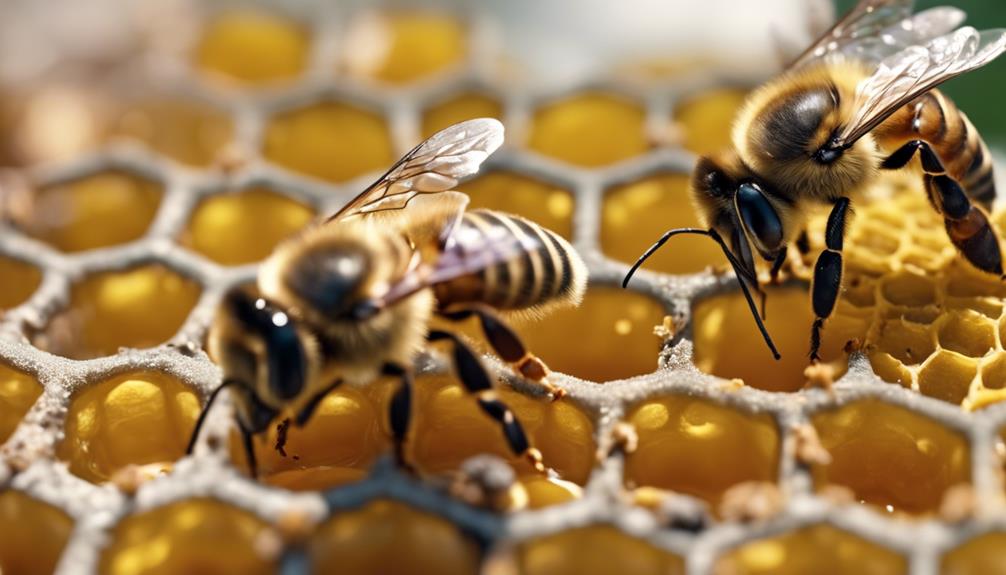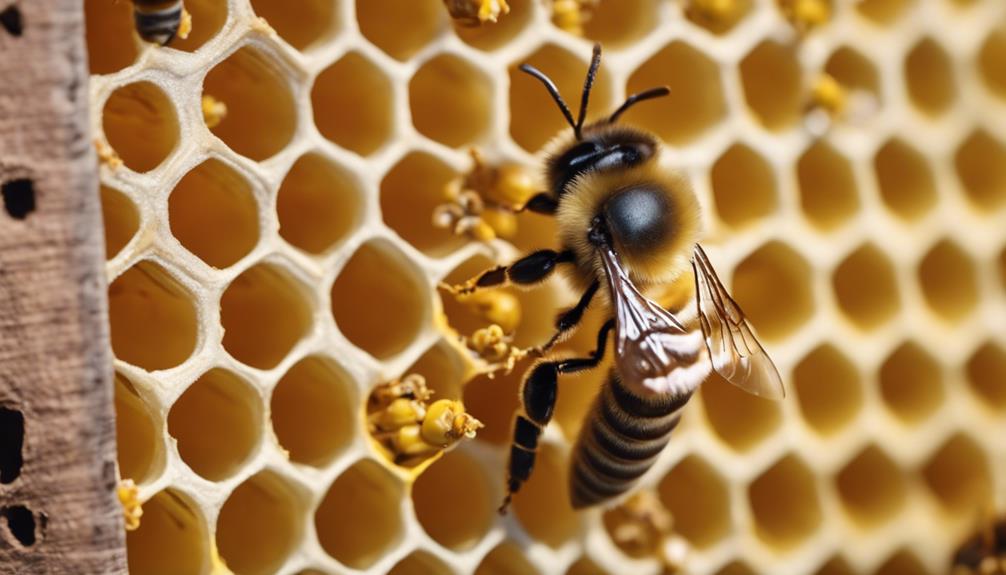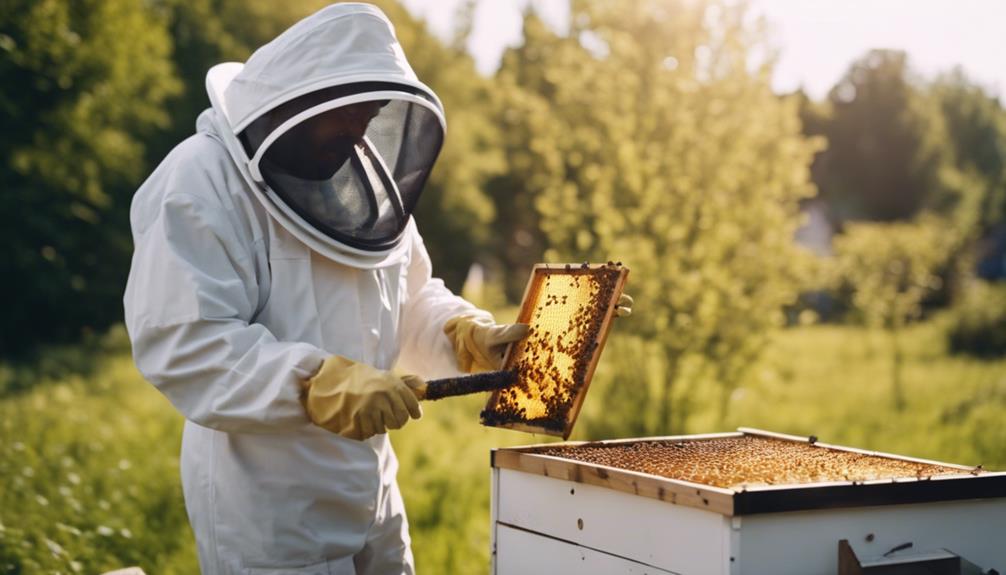Worker bees are the masterminds behind the delicious honey you enjoy. These busy bees collect nectar from flowers using their proboscis and store it in their honey stomach for the journey back to the hive. Once there, they transform the nectar into honey inside honeycomb cells, diligently fanning it to remove excess moisture. Did you know that the collective effort of worker bees can produce up to two pounds of honey per day? It’s truly a remarkable process worth learning more about.
Main Points
- Worker bees make honey by collecting nectar from flowers.
- They transform nectar into honey inside honeycomb cells.
- The collective effort of worker bees yields up to two pounds of honey per day.
- Honey is the primary food source for the bee colony.
- Surplus honey is harvested by beekeepers for various uses.
Worker Bees Role in Honey Production
Do worker bees play an essential role in the production of honey?
Worker bees are the true heroes behind the scenes in honey production. These industrious insects tirelessly collect nectar from flowers, bringing it back to the hive to be transformed into delicious honey.
Once inside the hive, worker bees deposit the nectar into honeycomb cells made of beeswax. Through a fascinating process, they fan the nectar with their wings, reducing its moisture content and thickening it into the golden goodness we all love.
Each worker bee might only produce a tiny amount of honey individually, but together, their collective effort can yield up to two pounds of honey per day. It’s truly remarkable how these tiny creatures work together to create such a sweet result!
Nectar Collection by Worker Bees
Worker bees efficiently collect nectar from flowers using their proboscis, storing it in their honey stomach for transportation back to the hive. Once the worker bee locates a flower with nectar, it extends its proboscis to suck up the sweet liquid, filling its honey stomach. This incredible process allows the bee to carry a substantial amount of nectar back to the hive.
Imagine these tiny creatures zipping from flower to flower, diligently gathering nectar to contribute to the hive’s honey production. The worker bees‘ role in nectar collection is essential for the colony’s survival, as this nectar serves as the raw material for the delicious honey we enjoy. It’s truly remarkable how these bees work together to create such a delectable treat!
Processing Nectar Into Honey

After collecting nectar from flowers, worker bees begin the process of transforming it into honey through a series of intricate steps.
The nectar is stored temporarily in the honey bee’s honey stomach, where enzymes work their magic to break down complex sugars into simpler ones like glucose and fructose.
Through regurgitation, the partially dehydrated nectar is deposited into honeycomb cells.
Worker bees then fan the nectar with their wings, helping to evaporate excess moisture and thicken the mixture.
Once the honey reaches the perfect consistency, the bees cap the cells with beeswax.
This sealed honey is left to ripen until it’s ready to be used as a nutritious food source for the hive or harvested by beekeepers.
Honey-making truly is a fascinating process!
Storage of Honey by Worker Bees
Worker bees meticulously construct honeycombs to store honey, showcasing their remarkable architectural skills. They employ various preservation techniques like capping the cells with beeswax, ensuring the honey remains fresh and uncontaminated.
These storage locations within the hive serve as crucial repositories of energy for the colony’s sustenance.
Honeycomb Construction Process
Constructing honeycombs from beeswax, we worker bees meticulously create hexagonal cells for storing honey and larvae in the hive. These cells aren’t just vitally shaped; their hexagonal design allows for efficient storage and use of space.
When we store honey in these cells, some nectar may have excess moisture. To tackle this, we fan our wings over the cells, helping evaporate the extra water and thicken the honey.
Once a cell is filled with honey, we cap it off with more beeswax, sealing in the golden goodness. This process of honeycomb construction and honey storage is essential for the survival of our hive, ensuring we’ve plenty of food to sustain ourselves and our queen.
Honey Preservation Techniques
Preserving honey through meticulous storage in hexagonal wax cells within the hive is an essential practice undertaken by worker bees to ensure long-term sustenance for the colony. Worker bees cap these cells with beeswax to shield the honey from moisture and air, ensuring its purity.
By regulating the humidity and temperature in the hive, worker bees create an ideal environment for honey preservation. The antimicrobial properties of honey play a significant role in preventing spoilage, allowing worker bees to store it for extended periods.
Through their diligent effort to fan and dehydrate nectar, worker bees reduce its moisture content, transforming it into the golden goodness we know as honey, ready for long-term storage within the hive.
Honey Storage Locations
Within the intricate network of the hive, honey storage locations are strategically positioned to optimize temperature regulation and accessibility for worker bees. Worker bees store honey in hexagonal wax cells, carefully sealing them in capped cells to shield the precious contents from moisture and contaminants.
To guarantee long-term honey preservation, worker bees diligently fan the honey with their wings, reducing its water content. These storage areas vary within the hive, with some closer to the center for warmth and others towards the periphery for easy access.
The conscientious efforts of these worker bees in maintaining honey stores play a crucial role in the survival of the colony, especially during winter months when food sources are scarce. The organization and dedication of these tiny creatures are truly remarkable for ensuring the colony’s well-being.
Importance of Honey for Bee Colony
Honey plays an essential role in sustaining the bee colony by serving as their primary source of food. Here are some key reasons why honey is important for the bee colony’s survival:
- Energy Source: Stored honey provides bees with energy, especially during times of scarcity like winter.
- Nutritional Needs: Bees use honey to feed larvae, queen bees, and themselves, ensuring the colony’s nutritional requirements are met.
- Production Process: Worker bees collect nectar, transforming it into honey through regurgitation and evaporation.
- Full Colony Support: Honey sustains the entire bee colony, from the youngest larvae to the oldest queen bee.
- Human Consumption: Surplus honey produced by bees is harvested by beekeepers for various uses, including human consumption.
Worker Bees Contribution to Colony

As worker bees diligently collect nectar and pollen, they contribute significantly to the overall sustenance and survival of the bee colony. These industrious bees play a critical role in creating the honey that serves as the primary food source for the entire colony.
By transforming the nectar they gather into honey through a process of dehydration and enzyme activity, worker bees guarantee that the hive is stocked with this essential resource. They meticulously store the honey in honeycomb cells made of beeswax, carefully organizing and preserving it for consumption and future use.
The surplus honey produced by these dedicated workers can even be harvested by beekeepers, providing not only for the bees but also for human consumption. Worker bees are truly the lifeblood of the colony, tirelessly working to sustain their home.
Worker Bees Vital Food Creation
Gathering nectar from flowers and skillfully transforming it into honey, worker bees play an essential role in creating the primary food source for their colony. Here are some fascinating facts about how worker bees create honey:
- Worker bees make honey by collecting nectar from flowers and storing it in honeycombs.
- They use enzymes to break down the nectar into honey and fan the honeycomb to dry the substance.
- Worker bees cap the honeycomb cells with beeswax to seal the honey for long-term storage.
- The stored honey serves as the primary food source for the colony, especially during winter months.
- In a productive hive, worker bees can produce up to two pounds of honey per day.

Hello! My name is Noel Calvin. I graduated from UCLA and now work as a writer at Launch Ninjas. I write blog posts that inspire and guide our readers in their entrepreneurial pursuits. I live in Pleasantville, NJ, with a peaceful yet lively atmosphere that inspires me.
Writing stories is more than just a job for me. It allows me to share my observations and satisfy my curiosity about the world. I combine my analytical skills with creative enthusiasm to delve into technology trends and startup stories. But my life isn’t limited to screens and keyboards. I value loyalty, passion, and a touch of old-fashioned charm, which I infuse into every narrative I create.
I love spending time in my garage, jamming with my band when I’m not writing. Playing the guitar and singing bring me immense joy. I also enjoy capturing ordinary and extraordinary moments through my camera lens and exploring new culinary adventures that excite my taste buds. I’m always seeking new experiences.
My family is very important to me. Joyful Sunday brunches filled with laughter and intense board game nights keep me grounded, reminding me of life’s simple pleasures.
In my world, every moment is an opportunity for discovery. Every discovery is a story worth sharing, whether a heartfelt moment at home or the pulse of technological innovations. Join me as I navigate through life, one blog post, one guitar strum, and one heartwarming family dinner at a time.


